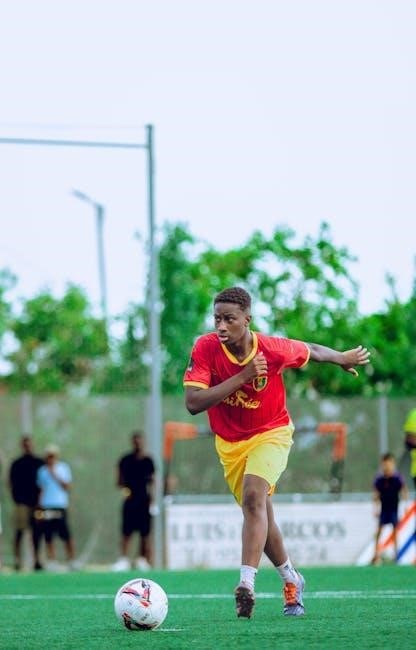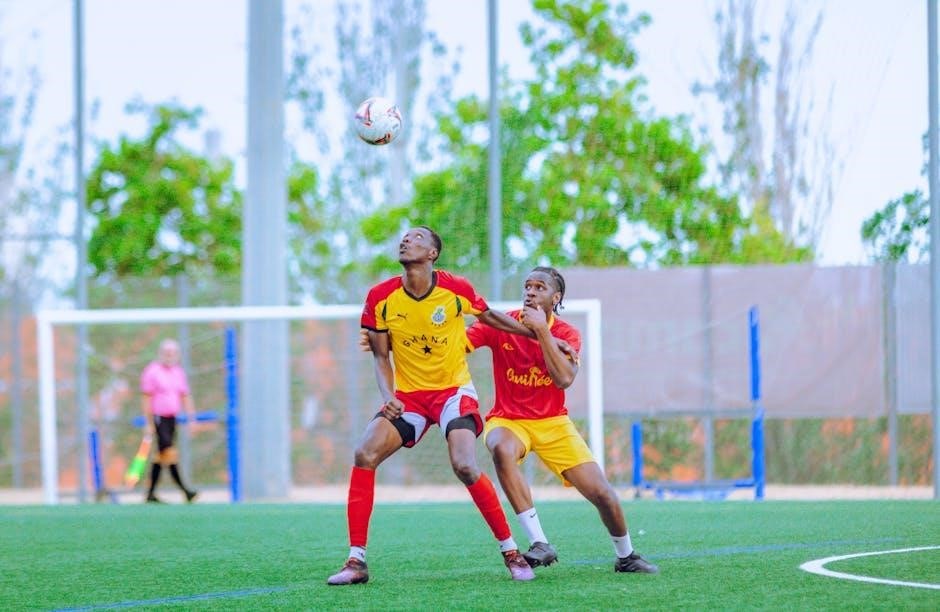The “Oh Crap Potty Training” method offers a modern, child-led approach to potty training, emphasizing recognition of bodily cues and creating a stress-free environment for kids to learn independently.
Overview of the “Oh Crap Potty Training” Approach
The “Oh Crap Potty Training” method is a child-led, stress-free approach to potty training that focuses on recognizing and responding to a child’s natural bodily cues. It emphasizes creating a supportive environment where children feel encouraged to take ownership of their learning process. The method avoids rigid schedules and instead prioritizes flexibility, allowing parents to adapt to their child’s unique pace. By eliminating pressure and fostering independence, the approach aims to make potty training a positive experience for both children and parents. It also provides practical strategies for handling common challenges, such as accidents and resistance, while promoting patience and consistency. This method has gained popularity for its realistic and empathetic approach to teaching children the skills they need for diaper freedom.
Why the “Oh Crap” Method is Popular Among Modern Parents
The “Oh Crap” potty training method has gained widespread popularity among modern parents due to its practical, flexible, and child-centered approach. Unlike traditional methods that often rely on strict schedules and punishment for accidents, this method emphasizes understanding and responding to a child’s bodily cues, making it more aligned with contemporary parenting values. Parents appreciate the method’s focus on fostering independence and reducing stress, which creates a positive experience for both the child and the caregiver. Additionally, the method’s adaptability to different learning paces and its realistic expectations resonate with busy, modern families seeking effective yet gentle solutions. The approach also encourages open communication and patience, which are key elements in building a child’s confidence and self-reliance during potty training.

Understanding the Core Principles of the Method
The “Oh Crap” method focuses on child-led learning, emphasizing bodily awareness and a stress-free environment to promote independence and successful potty training experiences for young children.

Child-Led Training: The Foundation of the “Oh Crap” Philosophy
The “Oh Crap” method revolves around child-led training, where the child’s readiness and natural cues guide the potty training process. This approach avoids rigid schedules, allowing children to take the lead in learning. By observing their bodily signals, kids develop self-awareness and independence. Parents act as supporters, not enforcers, fostering a positive and empowering experience. This philosophy reduces stress and anxiety, creating a collaborative environment where the child feels in control of their learning journey. The method emphasizes patience and adaptability, ensuring that each child progresses at their own pace. By focusing on the child’s instincts and comfort, the “Oh Crap” approach sets the stage for successful and lasting potty training outcomes.
The Importance of Recognizing a Child’s Bodily Cues
Recognizing a child’s bodily cues is a cornerstone of the “Oh Crap” potty training method. Children often exhibit specific behaviors when they need to use the bathroom, such as squatting, hiding, or becoming still. These signals are crucial for parents to identify, as they indicate readiness to learn. By paying attention to these cues, parents can help their child connect the sensation of needing to go with the action of using the potty. This approach reduces accidents and builds trust, as the child feels understood and supported. Over time, this awareness becomes second nature, helping the child transition smoothly from diapers to underwear and fostering confidence in their ability to manage their bodily functions independently.
How to Create a Stress-Free Potty Training Environment
Creating a stress-free potty training environment is crucial for the success of the “Oh Crap” method. This approach emphasizes patience and consistency, allowing the child to lead the process without pressure. By fostering a calm and encouraging atmosphere, parents can help their child feel more comfortable and confident. Positive reinforcement plays a significant role in this process, as praising small achievements can motivate the child to continue learning. It’s important to celebrate every success, no matter how minor, to build the child’s self-esteem and encourage them to keep going. Additionally, making the child feel like an active participant rather than being forced into training can reduce resistance and anxiety. Involving the child in the process, such as letting them choose their own potty seat or underwear, can give them a sense of control and ownership over their learning. Preparation is also key; having all necessary supplies easily accessible and establishing a predictable routine can help maintain a stress-free environment. This method not only aids in successful potty training but also strengthens the bond between parent and child, as it encourages teamwork and mutual support. By focusing on these elements, parents can create an environment that promotes learning and reduces the likelihood of setbacks or frustration.
Preparing for Potty Training
Identify readiness signs, gather essential supplies like potty chairs and underwear, and discuss the process with your child to build excitement and understanding before beginning.

Signs Your Child is Ready for Potty Training
Identifying when your child is ready for potty training is crucial for success. Look for signs such as staying dry for longer periods, showing discomfort with a soiled diaper, or expressing interest in the toilet. Many children exhibit curiosity about the bathroom habits of others, like wanting to imitate siblings or parents. Verbal or physical cues, such as squatting or hiding to go, are also indicators. Some toddlers may even ask to wear underwear, signaling their readiness to transition. The “Oh Crap” method emphasizes paying attention to these individual signs, as every child develops at their own pace. By recognizing these cues, you can create a smooth and stress-free potty training experience tailored to your child’s unique needs and personality.
Essential Supplies You’ll Need for Potty Training
Preparing the right supplies is key to a successful potty training experience. A potty chair or a training seat that fits on the toilet is a must, allowing your child to feel comfortable and secure. Training underwear or undies with fun designs can motivate your child to use the potty and help them feel like a “big kid.” Keep plenty of wipes and cleaning supplies on hand for accidents. A small stool can be helpful for little ones to reach the toilet. Visual aids like charts or apps can track progress and encourage consistency. Rewards such as stickers or small treats can also be motivating. Optional items like training pants or a portable potty can provide convenience during outings. Having these supplies ready will help create a supportive environment for your child to learn and grow.
How to Talk to Your Child About Using the Potty
Communicating with your child about using the potty is crucial for their understanding and willingness to participate. Start by explaining the purpose of the potty in simple, positive terms, emphasizing that it’s a natural part of growing up. Use engaging language and make the conversation interactive, asking questions like, “Do you think it’s time to try the potty?” Encourage your child to share their thoughts or concerns, and address any fears gently. Avoid forcing the topic but instead, create a supportive atmosphere where your child feels comfortable asking questions. Celebrate small successes with praise, such as, “I’m so proud of you for sitting on the potty!” This positive reinforcement builds confidence. Be patient and consistent, ensuring your child understands that accidents are part of the learning process. By fostering open and encouraging communication, you help your child feel empowered to take control of their potty training journey.

The Step-by-Step Potty Training Process
The “Oh Crap” method guides parents through a structured, child-led approach, introducing the potty, encouraging attempts, transitioning to underwear, and handling accidents with patience and consistency.
Phase 1 focuses on familiarizing your child with the potty chair, making it a comfortable and non-intimidating experience. Parents are encouraged to present the potty as a tool, allowing the child to explore and understand its purpose without pressure. This phase emphasizes letting the child approach the potty at their own pace, fostering curiosity and acceptance. It’s important to create a positive association by involving the child in the process, such as letting them choose the potty chair or decorating it together. The goal is to build comfort and familiarity, laying the groundwork for future phases. This introductory step is crucial for establishing a stress-free foundation and encouraging the child’s natural interest in using the potty independently.
Phase 2: Encouraging Your Child to Sit and Try
Phase 2 involves gently encouraging your child to sit on the potty and attempt to go, focusing on building their confidence and comfort. Parents are advised to create a routine, such as sitting the child on the potty after waking up, after meals, or before leaving the house. This phase emphasizes patience and consistency, allowing the child to explore the potty without pressure. It’s important to avoid forcing the child to sit for long periods, as this could create resistance. Instead, make the experience engaging by reading a book or singing a song together. The goal is to help the child associate the potty with its intended use while fostering a sense of independence and accomplishment. Positive reinforcement, even for small attempts, is key to progressing smoothly to the next phase.
Phase 3: Transitioning from Diapers to Underwear
Phase 3 marks the exciting transition from diapers to underwear, a milestone that helps your child feel more grown-up and responsible. At this stage, children are encouraged to wear underwear full-time, which helps them develop a stronger connection to their bodily sensations. Accidents may still occur, but they are viewed as learning opportunities rather than failures. Parents are advised to remain calm and avoid scolding, as this could undermine the child’s confidence. Instead, focus on guiding them to recognize when they need to go and praising their efforts, even if they don’t succeed every time. This phase reinforces the child’s independence and understanding of the potty’s purpose, setting the stage for consistent success in the next phase.
Phase 4: Handling Accidents and Setbacks
Accidents are an inevitable part of the potty training process, and Phase 4 focuses on how to handle them constructively. Instead of scolding or punishing, parents are encouraged to remain calm and use these moments as teaching opportunities. Guide your child to recognize the signs that they need to go and help them understand the consequences of ignoring these cues. Encourage them to take responsibility by helping clean up and trying again. It’s important to stay patient and consistent, as setbacks can be frustrating but are a natural part of learning. By framing accidents as learning experiences rather than failures, you help build your child’s confidence and resilience. Remember, progress may not always be linear, but with the right mindset, your child will eventually master the skill.

Common Challenges and Solutions
Common challenges include resistance, accidents, and nighttime struggles. Solutions involve patience, consistency, and positive reinforcement, helping children overcome setbacks and build confidence in using the potty successfully.
Dealing with Resistance to the Potty
Resistance is a common challenge during potty training, often stemming from fear, stubbornness, or a lack of readiness. It’s important to remain calm and patient, avoiding power struggles. Parents should create a positive environment by praising efforts, not just successes. Using visual aids, like charts or rewards, can motivate children to engage with the process. Consistency is key; stick to routines but allow the child to take the lead. If a child refuses to sit or shows discomfort, gently encourage them without forcing. Offering small rewards for attempts, even if unsuccessful, can build confidence. Remember, every child progresses at their own pace. Avoid punishment or negative reinforcement, as this can create lasting resistance. Instead, focus on celebrating small victories and fostering independence.
Strategies for Nighttime Potty Training
Nighttime potty training can be challenging, but with consistency and patience, success is achievable. Start by transitioning from diapers to underwear at night once your child shows readiness, such as staying dry through naps. Encourage your child to use the bathroom immediately before bedtime and limit fluids close to bedtime. Create a calming pre-bed routine that includes a final trip to the potty. If accidents occur, avoid punishment and instead treat them as learning opportunities. Use protective gear like mattress protectors to reduce stress. Gradually phase out nighttime diapers, ensuring consistency between daytime and nighttime routines. Positive reinforcement is key; praise efforts and progress, even if setbacks happen. Over time, most children master nighttime potty training, building confidence and independence.
Managing Public Bathroom Situations
Public bathrooms can present challenges during potty training, but with preparation and consistency, these situations can be managed effectively. Teach your child to navigate public restrooms confidently by explaining the process beforehand and ensuring they can reach the toilet independently. Bring a portable potty or seat reducer for emergencies and keep wipes handy for cleanups. Encourage your child to communicate their needs clearly, such as asking for help or expressing discomfort. Normalize the experience by discussing it calmly, reducing anxiety. If your child resists using public bathrooms, reassure them and offer support without forcing compliance. Consistency in routines and positive reinforcement will help your child adapt to new environments. Over time, they will become more comfortable and independent in public settings, mastering this critical life skill.
The Role of Parents in the Potty Training Process
Parents play a vital role by providing consistent guidance, maintaining patience, and fostering independence, allowing children to take ownership of their potty training journey with confidence.
How to Stay Patient and Consistent
Staying patient and consistent is crucial during potty training. Parents should avoid pushing their child too hard, as this can create resistance. Instead, focus on creating a routine that aligns with the child’s natural cues. Celebrate small successes to build confidence and maintain a positive attitude. Consistency helps the child understand expectations, reducing confusion. If accidents occur, approach them calmly without scolding, using them as learning opportunities. It’s important to remember that every child progresses at their own pace, and patience fosters a stress-free environment. By remaining consistent and patient, parents can help their child master potty training more effectively and efficiently.
Communicating Effectively with Your Child
Effective communication is key to successful potty training. Use simple, clear language to explain the process, ensuring your child understands the concept. Encourage open dialogue by asking about their feelings or needs, fostering a sense of control. Positive reinforcement through praise or rewards boosts confidence and motivation. Avoid negative language or criticism, as it may lead to resistance. Instead, frame accidents as learning opportunities, emphasizing effort over perfection. Being approachable and supportive helps your child feel comfortable seeking help or discussing challenges, creating a collaborative environment for potty training success. Clear communication builds trust and accelerates the learning process, making the journey smoother for both parent and child.

Building Confidence and Encouraging Independence
Building confidence and encouraging independence are central to the “Oh Crap” method. Celebrate small victories, like successfully using the potty, to reinforce your child’s sense of accomplishment. Allow them to take ownership of the process, such as choosing underwear or wiping themselves, which fosters a sense of pride and responsibility. Gradually transition responsibility from you to your child, letting them lead while offering support when needed. This approach helps your child feel empowered and capable, reducing reliance on diapers and building self-esteem. Be patient and encouraging, even during setbacks, as this strengthens their confidence and motivation to continue learning. By fostering independence, you help your child develop essential life skills and a positive self-image that extends beyond potty training.
Additional Tips and Resources
Use visual aids like charts or apps to track progress and motivate your child. Reward systems, such as stickers, can enhance engagement and celebrate milestones. Explore recommended products, like potty chairs or training underwear, to support the process and ensure success.
Recommended Products for Potty Training Success
Investing in the right tools can significantly ease the potty training journey. A good potty chair or a transition seat for the toilet is essential, as it provides a comfortable and familiar space for your child. Training underwear with built-in protection can help your child feel like a “big kid” while offering security during accidents. Step stools or booster seats are also helpful for little ones to reach the toilet independently. Additionally, non-slip grips or adhesive potty seats can make the experience less intimidating. Cleaning supplies, such as wipes or a small handheld vacuum, can be lifesavers for quick cleanups. Visual aids like potty training charts or apps can motivate your child and track progress. Lastly, consider rewards like stickers or small toys to celebrate milestones and reinforce positive behavior.
Using Visual Aids and Rewards
Visual aids and rewards play a pivotal role in motivating children during potty training. Sticker charts or progress trackers allow kids to see their achievements, fostering a sense of accomplishment. Small rewards, such as stickers or special privileges, can be powerful incentives for successful uses of the potty. For younger children, visual aids like potty training apps or videos can make the process engaging and fun. Rewards should be immediate and consistent to reinforce positive behavior. Additionally, praise and encouragement are equally effective, helping build confidence and self-esteem. By combining visual tools with rewarding experiences, parents can create a positive and motivating environment that encourages their child to embrace potty training with enthusiasm and determination;
Where to Find Additional Support and Guidance
For parents seeking additional support and guidance, numerous resources are available to complement the “Oh Crap Potty Training” method. The official book by Jamie Glowacki provides in-depth strategies and troubleshooting tips. Online communities, such as forums and social media groups, offer a space to share experiences and advice with other parents. Podcasts dedicated to potty training, including episodes featuring the “Oh Crap” method, provide actionable insights and real-life success stories. Websites and blogs often share tips, product recommendations, and encouragement tailored to this approach. Additionally, local parenting groups and libraries may offer workshops or access to resources that align with the “Oh Crap” philosophy. These diverse platforms ensure parents have ongoing support as they navigate their child’s potty training journey with confidence and success.

The “Oh Crap Potty Training” method empowers parents to guide their children toward diaper freedom with patience, consistency, and a focus on their child’s unique readiness and cues.

The Long-Term Benefits of the “Oh Crap” Method

The “Oh Crap” method fosters independence and self-confidence in children, reducing the risk of long-term potty training challenges. By focusing on a child’s natural cues and readiness, it encourages a positive association with the potty, leading to faster mastery and fewer accidents over time. This approach also minimizes power struggles, creating a less stressful environment for both parents and children. Additionally, the method’s emphasis on understanding bodily signals can contribute to better bladder and bowel control in the long run. Parents often report higher success rates and fewer setbacks, making the “Oh Crap” method a sustainable and effective choice for many families. Its benefits extend beyond potty training, promoting a healthier relationship with personal hygiene and self-care.
Final Thoughts on Achieving Diaper Freedom
Achieving diaper freedom with the “Oh Crap” method is a milestone that brings relief and pride for both parents and children. This approach, which focuses on a child’s readiness and natural cues, ensures a smoother transition to independence. By eliminating the pressure of rigid schedules and emphasizing a stress-free environment, the method reduces anxiety and resistance. Parents often find that the long-term benefits, such as improved self-confidence and better bladder control, make the effort worthwhile. The “Oh Crap” method not only helps children master the potty but also fosters a positive attitude toward personal hygiene. With patience and consistency, families can say goodbye to diapers and hello to a more independent, empowered child.
Leave a Reply
You must be logged in to post a comment.